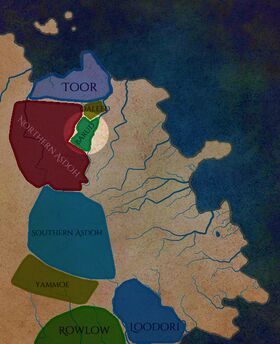Difference between revisions of "Empire of Barud"
| Line 4: | Line 4: | ||
|capital=Barudse, Korstonoh | |capital=Barudse, Korstonoh | ||
|government=absolute monarchy | |government=absolute monarchy | ||
| − | |language=[[Bukk|Eastern Torv]] | + | |language=[[Bukk|Asdoh, Eastern Torv]] |
|religion=[[Xaewoon]] | |religion=[[Xaewoon]] | ||
|established=1880s [[FR]] | |established=1880s [[FR]] | ||
Revision as of 22:45, 7 March 2021
| Empire of Barud | |
| Political details | |
|---|---|
| Capital | Barudse, Korstonoh |
| Government | absolute monarchy |
| Language | Asdoh, Eastern Torv |
| Religion | Xaewoon |
| Historical details | |
| Established | 1880s FR |
| Disestablished | 188 SR |
Empire of Barud /bɑː'ruː/ was an early Tarnarian civilization. In spite of its small size compared to its neighbors, it was notable for its claims of military grandeur and multiple conquests. In spite of aggressive rhetoric, Barud was unable to expand and after a long series of unsuccessful campaigns fell into a prolonged phase of decline. It is believed that Barud's failure strongly informed Yammoe's clandestine expansionist strategy.
Nevertheless, Barud was a major player in the region and in many ways defined northern Tarnarian culture at the start of the millennium. The empire was officially dissolved in the 2nd CSR, with some of its remaining bastions overrun by Stogen.
Etymology
The word "Barud" is thought to be derived from the Asdoh word "Baru" that meant "dough", but was more often used in a sense of "common folk". Adding the "d" postfix to the end of a word would indicate a geographical area, which was a standard linguistic device in Asdoh (both the language and the state) at the time. Therefore, "Barud" would mean "the land of the common folk".
History
Barud was founded by the Gordoh family, who were the founders of the secessionist Gordohse, a Asdoh city that was a self-proclaimed city state, but was not recognized as such by Asdoh's capital Estonoh. At some point in the 1880s FR, the Gordohs and their supporters abandoned the city and traveled east. They then settled on the western bank of Quoon River. The settlement was named Barudse, "the place of the common folk".
Over the course of the next several decades, Barudse was developed into a bustling city and a new city, Korstonoh, was founded on the eastern bank of Quoon West Fork. A network of roads was built between both cities, emulating Asdoh's approach.
First ultimatums
In 1912 FR Hun Nov Von Gordoh proclaimed himself emperor and issued an ultimatum to Estonoh, threatening "a great deal of pain and horror thrust upon the gentle people of Asdoh, lest they don't bow to the only true Ruler Between the Earth and the Sky, the One Led by Providence, the Great Emperor of Barud and its Chosen People".
When Asdoh's government ignored the ultimatum, Hun issued the second ultimatum, this time asserting that Barud had "claimed all the land east of Quoon River and all its peoples that are at this moment ready to march on the city of cowards."
Porteek specifically mentions a number of insults that were included in the ultimatum, addressed towards specific individuals in the Asdoh government hierarchy, all of whom were by this time "either dead or forgotten". Porteek then suggests that the names came from Malyn Gordoh, who knew them when fighting for independence back in Gordohse.
The second ultimatum did receive a response, which called Hun "a phony emperor, a disgrace to his parents and siblings, who should now bear the mark of eternal shame on their foreheads for the sheer stupidity of the One Led by Providence".
First Asdoh campaign
Emperor Hun led his troops on Estonoh in 1914 FR. They stationed at the deserted Gordohse, which by that time had turned into ruins, and then marched on Estonoh.
It is not clear how big the army was, but accounts seem to indicate that it was impressive. According to Ludoh, "it was an army so massive that when they approached Estonoh, a shadow was cast across the streets. Emperor's soldiers were so tall that when they stacked themselves into human columns, they could block out the sun".
Porteek is more reserved in his descriptions, but also mentions the trick of soldiers standing on each other's shoulders to give an appearance of extraordinary height.
Estonoh's rulers did not expect Emperor Hun to actually act on his threats. They fled the city, ordering its army and citizens to hastily retreat. Emperor Hun entered Estonoh and proclaimed himself to be the ruler of Asdoh. Because both times Emperor Hun's troops entered a deserted city - first Gordohse and then Estonoh - Porteek calls the campaign "the campaign of deserted cities".
Emperor Hun then installed Mortel Baoneek as the King of Asdoh and left the city with most of his army. Mere two weeks later the original army of Estonoh, bolstered by reinforcements from the Luzoh fortress, entered the city, easily defeating Mortel's regiment. Mortel and his court were swiftly executed.
The army then followed Emperor Hun to the south and located him stationed at Gordohse again. They engaged and this time Emperor Hun was forced to retreat. His troops, however, suffered heavy losses and several of the emperor's generals advised him to end the campaign. Records indicate that the Emperor was back in Barudse in 1916 FR.
